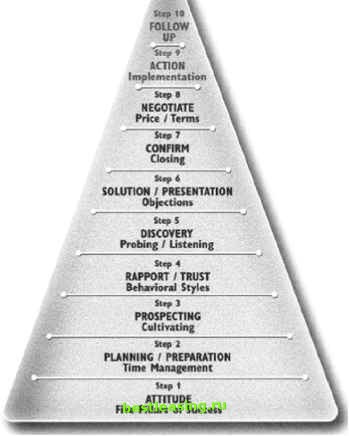

 |
 |

|
Промышленный лизинг
Методички
Low of 10 Options A few years ago I had the pleasure of hearing Jim Rohn, an international motivational speaker, speak at a sales conference in Calgary. One of his many suggestions was to be guided in life, and in sales, by the Law of Ten Options. His point is this: with a cancellation or postponement of an event, there are always ten other options-ten alternatives to consider. For example: if you and your spouse had planned an evening out with the Jones but at the last minute they gracefully declined due to sickness, you now have ten options to consider-go see a movie, see a play, visit other friends, clean the garage, read a book and so on. All is not lost because of a sudden change in plans. The first five or six options may present themselves quite readily, whereas the final three or four may require some creative thinking -perhaps even some alternatives outside your comfort zone. It works well. My wife and I often discuss our ten options and frequently come up with options that are as enjoyable or more enjoyable than the original cancelled event. Rohns law can be applied to all situations and it can be particularly useful in pursuing the spirit of creative negotiation. Have some fun with it. Anyone with teenagers will immediately understand how effective it can be-teenagers exercise the Law of Ten Options on a daily basis. Negotiation is not a game with a single objective but rather one step in building effective long-term relationships. It is only one of the ten steps in your Sequential Model but it can be the pivotal point in your relationship and your success. During negotiation you forge an agreement-like taking the relationship from a courtship to a marriage. Will you marry me? may not be your actual request but your final confirmation (the five magic words) certainly suggests the commitment and responsibilities of a marriage. One of the surest ways to successful negotiation is to be well prepared. Its essential, but planning is often overlooked in the excitement of approaching the finish line. Its like training and conditioning to run a marathon but then running out of steam at the 24-mile mark. So many salespeople come close to the finish line but fail to complete the race because of a lack of training and preparation. We cannot afford to ignore the dire consequences of inadequate preparation. Planning is not an isolated step of your Sequential Model but is a prerequisite to successful graduation of each and every step-including creative negotiation. The skills outlined in this chapter will help you to build confidence and reach your business and personal objectives. Understand not only how to negotiate, but when. Review the five principles regularly and continue to fuel your confidence to not only run a good marathon, but to finish it.  ЦШ И1:11 Notes 1. Achievers International. Creative Negotiations Workshop. 1989.  Congratulations, you have now completed Step #8   ABC Amber CHM Converter Trial version ase register to remove this banner. http: www.processteHt.com/abcchm.html ЦгА1 НИЛМШШ рД Chapter 11: Action Plan: Implementation Congratulations on your successful negotiation. The customer said yes, you reached a win-win-win-win agreement, and now its time to take action. This is what you have been working so hard to achieve, the opportunity to showcase your company and your product, and to deliver on all the benefits and promises you presented earlier. However, in many ways, your job is just beginning. Just as in a marriage the, I do should be, I will do. Your customers have high expectations-dont let them down. In fact, the more they spend, the higher their expectations. People expect their purchases to be perfect and hassle-free. Surprisingly, the details of an effective action plan are often overlooked in the euphoria of finally anchoring the deal. Nevertheless, your role now is to quarterback all the activities necessary for a smooth, seamless implementation rather than race to the car, dig out a calculator and excitedly work out your commission and/or bonus. Its important that you identify and delegate responsibilities to ensure a timely, hassle-free delivery of your solution. A big part of what your customer just purchased is peace of mind about a worry-free delivery. Customers need to feel they have made a wise, intelligent investment. Initially they may feel a little uneasy, insecure about their decision. After all, you have convinced them to embrace change. My People Need to Talk to Your People All parties must understand their roles and responsibilities and work in harmony for a smooth implementation. Its a good idea for both you and your customer to identify all parties involved in the implementation: This is what Ill do, within this time frame, and these are the people to involve. Parties involved may include management, operations, accounting, manufacturing, engineering, shipping/receiving, inventory control, technical people, delivery people, and so on. You cant do it alone, so draw on the strengths of your internal customers and your customers people to ensure a smooth, speedy, hassle-free implementation. With all parties working in harmony, the story of these four people becomes a reality: m WHAT WENT RIGHT? This iBour people: Everybody, Anybody, Somebody, and Nobody. There was an imponloBBldone and Nobody was sure that Anybody would do it but instead Somebody did it. Nobody got angry because it was Anybodys job. There was no need for Nobody to blame Anybody-Somebody did the job Anybody could have done. Nobody made excuses but Everybody was satisfied. CommunicBst of times is fraught with uncertainty, biases, and individual perceptions. Effective communication is a topic onto its own. Poor communication often results in costly oversights and mistakes. Communication is a very delicate, fragile process. As responsible sales entrepreneurs, we need to ensure an effective exchange of information. For larger, more sophisticated deals, I suggest both parties safeguard themselves against the normal pitfalls of communication and consider drafting a letter of intent or a letter of agreement. I dont mean a legal document that requires hiring a lawyer at $50 for every three minutes, I simply mean putting a letter together on your company letterhead outlining the logistics of the deal. Who is doing what and by when? You and your customer can review it for accuracy and completeness, signing your respective copies. Part of your responsibilities also include avoiding, or at least minimizing, user error. To do so you must evaluate your customers abilities, technical or otherwise, and recommend training if necessary. Research suggests that up to 30% of the time customers are wrong. Reported product and service problems resulted from customer error, product misuse, or failure to read the instructions. Customers do screw up, but as professionals we have to allow them to maintain dignity. It takes a strong attitude to 1 2 3 4 5 6 7 8 9 10 11 12 13 14 15 16 17 18 19 20 21 22 23 24 25 26 27 28 29 30 31 32 33 34 35 36 37 38 39 40 41 42 43 44 45 46 47 48 49 50 51 52 53 [ 54 ] 55 56 57 58 59 60 61 62 63 64 65 66 67 68 69 70 71 |